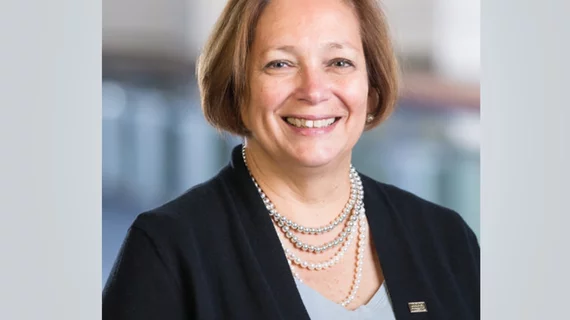'Time is ripe’ for radiologists to leave reading room: RSNA president offers 3 steps to get started
CHICAGO—With all of the forces aligning around the imaging profession, the “time is ripe” for radiologists to step out of the reading room and take on a much larger role in engaging patients.
Those forces include artificial intelligence freeing up extra time at the bedside, calls to eliminate unnecessary diagnostic tests that don’t add value, emerging team-based care models and the burnout crisis that’s pushing people away from the profession. RSNA President Valerie P. Jackson, MD, believes now is the moment for radiologists to begin “opening our profession’s cockpit door” and forge new connections.
“The healthcare environment is changing around us rapidly, and many of these factors suggest the time is truly ripe for increased interaction between radiologists and patients,” she told attendees at the society’s 105th Scientific Assembly and Annual Meeting, which kicked off Sunday, Dec. 1, in Chicago.
“But to get there, we need to look at patient interaction in new ways, from a variety of perspectives,” added Jackson, who is also executive director of the American Board of Radiology.
An avid image captor and traveler in her spare time, Jackson urged attendees to take a page from the photography profession to help speed this transition. She gave the example of three different types of specialized lenses that radiologists could try out to shift their own perspectives:
1) The telephoto lens allows one to zoom in from a great distance, which is what radiologists need to do when it comes to themselves, she noted. That includes asking some of the tough questions, such as: Are we really as introverted as we think we are?
“I don’t think so,” she said. “You don’t have to be an extrovert to connect with your patients, and you may have more social skills than you think.”
She suggested viewing such interactions similar to exercise or other routine tasks that require just a little extra effort, but are essential to daily life. Spillover benefits are sure to follow, including a feeling of purpose, improved mental health, added value to your practice, reducing errors and building trust. Engagement is a “burnout antidote,” she believes.
2) The macro lens, meanwhile, allows photographers to enlarge subjects and see them up close. Every radiologist would benefit from zooming in to better understand the factors that are contributing to each individual’s health, Jackson argued.
“When it comes to our patients, the point is well-taken,” she said. “We need to live in their world more often, putting ourselves in their shoes. And we need to enlarge our view of the patient experience, understanding it better.”
3) The wide-angle lens expands the field of vision and lets the image taker capture much more visual information. For radiologists, Jackson said, this would mean moving away from “insular” tendencies and considering the views of referring physicians and others on the care team.
“They are natural partners and an essential bridge to our patients, but in recent decades, we have let that bridge narrow,” Jackson said, pointing to new technologies and the erosion of face-to-face consultations as drivers for this narrowing. “The result of this can be standoffish and even strained relationships. We need to think bigger picture.”
Jackson closed her president’s address by translating those changes in perspective to three practical steps radiologists can take tomorrow to begin shifting their practice’s mindset:
- Engage with at least one patient next week, even if it means just going to the waiting room to introduce yourself. Ask a patient what they thought of their care, provide your contact information, and communicate the radiologist’s role in the care process, Jackson suggested.
- Connect with referring physician partners by reaching out to learn about their needs, advocate for an expanded role on the team, demonstrate your benefits, and collaborate on new communication tools that will allow the sharing of results in an alternate way.
- Fully embrace making this change by building a professional culture that values communication and engagement as a “core goal.” As gatekeepers of essential information, radiologists must develop better listening skills, be able to easily translate complex information, and demonstrate empathy, Jackson argued.
“For each of us as individual practitioners, I believe the most important step of all is to accept the fact that the end result of increased patient interaction is well worth the effort required. In a medical world that seems to move faster and faster each day with many uncertainties and new pressures, the temptation is to put our heads down and just hold on,” she closed her speech. “It takes courage to be willing—in the midst of the current environment in medicine—to make a conscious change in one’s perspective, and then to translate that perspective into new ways of working, especially when the incentives to make these changes are not always immediately apparent.”
“I know we can do it and each small effort on our part individually will add to the collective momentum in creating a new culture of patient interaction within radiology,” she added.

